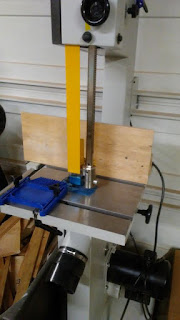From time to time, I drive an hour south of Tortuga Early Instruments Worldwide Headquarters in sunny Vancouver, Washington to visit the bustling Salem, Oregon workshop of Owen Daly Early Keyboard Instruments. Owen is a master builder who is kind, generous, and an all-around good guy, so I enjoy my visits immensely; they're especially nice now that I have more context under my belt to understand what it is he's talking about most of the time.
Today was no exception. I watched Owen put the finishing touches on the Donzelague (1711) copy he's been completing for the last couple of months. It's a beautiful instrument and it was an honor to play it and watch Owen tweak a few things here and there.
I've said it before and I'll say it again: Every time I visit the man, I come away with several new and exciting knowledge points. He really is a wellspring of wisdom and I think the world of him. I consider myself fortunate to have met him and look forward to my next trip down to soak up more knowledge.
As you probably know, I've got a couple of mini-projects related to the instrument in play at this time. First, I've been working on fixing the nameboard windows and getting it prepared for a front re-veneer exercise. When I mentioned to Owen what a pain in the rear-end the veneering has been, he simply looked at me and asked, "Why don't you just paint it?" My response was, "Um, I don't know. Why don't I just do that?" This is an example of Owen's deep well of experience and pragmatism that sometimes make me feel like a dumb-dumb.
So, all of the work I had done to prepare the name board for spraying on the 3M contact adhesive and to cut the veneer was, I hope, for naught.
I'm just done with the stupid veneer idea; it doesn't add anything to the instrument that some nice paint wouldn't accomplish. I will have to clean up the sides pretty substantially, but there are worse things - like veneering.
The other mini-project is preparing the soundboard to accept bracing and bridges. As you probably also know, I sold my beloved Delta 6" jointer (only to need it the very next day) and had to throw myself upon the mercy of Random Roger Green for the cleanup of the soundboard planks. As always, Roger was more than happy to help. He really is the best and I know, deep in my heart, that someday I will be able to do something nice for him (please leave your suggestions in the comments section below).
The first photo above is Roger going to town with the planks using his monstrous Powermatic jointer with a helical head. The joint sides cleaned up nicely and then Roger asked if I wanted to go ahead and run them through his monstrous Powermatic planer to clean up the faces. My response: "Heck, why not?" The results are illustrated in the bottom photo above. I'm quite happy with them and am looking forward to tearing the tape, plastic and newspaper off of the instrument so I can move it from the assembly table and get to work on jointing the boards.
On a completely unrelated note, after thinking about the resaw fence I had made for the Laguna SUV, I came to the conclusion that a 14" face was a bit much, so I trimmed it down to eight inches, which will still accommodate any width board I choose to move through it.
The next time I post, you will see how I went about jointing the planks of the soundboard, as well as a description of how I intend to go about hand planing them into submission.
Until next time...










No comments:
Post a Comment